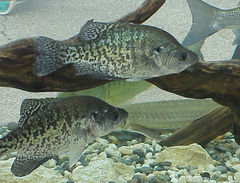
Pomoxis annularis
Bachelor perch, papermouth
The white crappie is deep-bodied and silvery in color, ranging from silvery-white on the belly to a silvery-green or even dark green on the back. There are several vertical bars on the sides. The shorter dorsal fin has a maximum of six spines, which differentiates it from the black crappie. Males may develop dark coloration in the throat region during the spring spawning season.
Adults feed on small fish and insects.
Before introduction efforts the range of the white crappie extended west to Minnesota and South Dakota in the north, and to northeastern Mexico in the south. Today the range extends east to the Atlantic coast, and west to include California and portions of Nevada, Arizona, New Mexico, Montana, Colorado, Utah, and North Dakota.
The white crappie is tolerant of a wide variety of conditions, including areas of silt and turbidity. This species is usually found near structure such as fallen trees, stumps, docks, rocks, and aquatic vegetation.
The white crappie is similar in size to the black crappie and will average 10 to 14 inches in length and a good size fish will weigh 1 to 2 pounds.
5 pounds, 3 ounces (Source - IGFA)